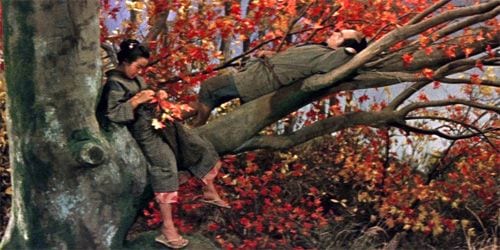
Even if his work is less recognized than that of other Japanese masters, like Akira Kurosawa and Yasujirō Ozu, Keisuke Kinoshita was probably one of the most prolific directors in the country’s history. Starting his career as a photographer, he slowly ascended the ladder in the legendary Shochiku Kamata Studios (home to filmmakers like Mikio Naruse and others) where he specialized in the art of diversity. Over his illustrious career he would experiment in genres that ranged from the epic to the family drama. Yet his most famous movies — at least in terms of his artistic legacy — are the ones that dealt with Japanese traditionalism in ways that still seem rather foreign to people in the Western world.
In The Ballad of Narayama, which turned out to be one of the most experimental films to arrive from Japan during the ‘50s, Kinoshita took a Japanese book (itself inspired by a traditional tale) and turned it into an artificial spectacle which combined kabuki theater with bittersweet storytelling akin to folk. The director was a master of the jidaigeki genre, which essentially dealt with period pieces set during the Edo periof of his country’s history.
The story in The Ballad of Narayama centers on the practice of ubasute, which was practiced in Japan during times of extreme poverty and famine, and consisted of carrying an elderly relative to the top of a mountain where they would eventually die from starvation, dehydration or a combination of both. While the practice itself has never been confirmed as being customary, it served as basis for endless legends and tales which shaped the way in which we think of Japan as a country ultimately concerned with utmost efficiency and the distribution of goods so that the young will always have a future ahead of them.
It could be said that this practice in a way, inspired the works of Ozu which have been characterized by a melancholy usually related to the way in which the elderly are left to their own devices, unable to catch up with modern times. However in The Ballad of Narayama, Kinoshita presents us with a reality that’s even cruder precisely because everything around it is so artificial. The movie was shot completely in studios (the sets which range from huts to elaborate landscapes are a true thing of beauty) and tells the story of the elderly Orin (played by Kinuyo Tanaka), a matriarch who comes to terms with the fact that her moment has arrived to travel to Mount Narayama in order to help her family survive a disastrous period of famine.
Strong, to the point where her endurance is painful to watch, the elderly woman convinces her son Tatsuhei (Teiji Takahashi) that he is better off living his life with his new wife Tama (Yuko Mochizuki) and in a series of tragic, but touching, scenes she proves her unworthiness of remaining with them. A harrowing scene even has her smash her own teeth in order to eat less and allows the young to have more. This comes as a pleasing turn of events for her cruel grandson Kesakichi (Danko Ichikawa) who pokes fun at her misfortunes with his pregnant girlfriend Matsu (Keiko Ogasawara). A crueler take on how the young forsake the old has rarely been put onscreen.
What remains thoroughly engaging and makes the movie even harder to watch is its stylized direction, which takes full advantage of the bittersweet magic of the sets by allowing us to think of the possibility of Orin finding a happy ending when she arrives to the ominous mountain. Of course, the movie here defies our conventions as a Western audience and forces us to see beyond the limited scope of what we’ve come to think we know about Japanese culture. Is her happiness perhaps completely related to giving her family a healthier future? While there is true horror in the dreamlike fantasia presented to us by the director, we can’t help but be haunted by the film’s endless feeling of fulfillment.
Why should Kinoshita present us with the reality we wish was true? Since the conventions of the narrative make it harder for us to simply give in to the storytelling, we are often left with long moments where we are allowed to reflect on what’s happening onscreen. Certainly this must have a different effect on people accustomed to kabuki performances who are undoubtedly transfixed by the power of the sung lines and the ultimate emotional punch of the story; and as such the movie can’t help but feel both universal and very distant.
The Criterion Collection has given the film a superb DVD edition with a new transfer that highlights the technicolor wonders of the film. Sadly, this is one occasion where bonus features would have made the experience richer for newbies to the genre, and on this rare time, the boutique house has left much to be desired. Extras are limited to a couple of theatrical trailers and a booklet with essays. Ideally though, those who are inspired by the film will undoubtedly seek out to learn more about its genre and especially about its maverick director.

![Call for Papers: All Things Reconsidered [MUSIC] May-August 2024](https://www.popmatters.com/wp-content/uploads/2024/04/all-things-reconsidered-call-music-may-2024-720x380.jpg)



